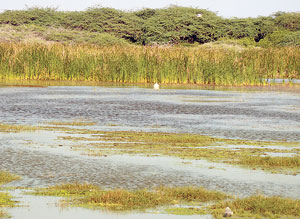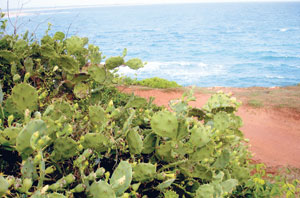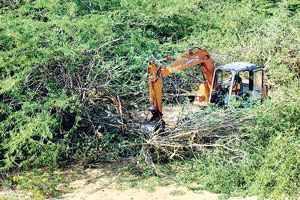The flamingoes have flown from Bundala. The National Park on Sri Lanka’s south-eastern coast, known for its water birds and picturesque landscapes of lagoons, water reeds, forest and wildlife is in crisis. Once a hot favourite with foreign and local tourists, the park now has few visitors.
The ecological significance of Bundala National Park as a habitat for water birds, and in particular, migratory shorebirds was recognized when it was named a RAMSAR site in 1991. But its water bodies have been contaminated and the park is choking under the spread of two invasive species of plants that are now estimated to cover some 60% of its land area. The International Conservation Union (IUCN) warns that 10,000 hectares in and around Bundala Park are now affected. These destructive species threaten the very existence of the park and its wildlife. Thick cactus covers the ground and the scrub plant Andara( Prosopis Juliflora) grows above, cutting off sunlight for other plants. The cactus is so thick and has grown to such proportions that animals cannot cross its poisonous thorns.
 |
| Part of a lagoon scene with the Andara at the far end |
 |
| Cactus that has spread to the other boundary of the park by the sea |
 |
| Uprooting work in progress |
These two invasive species have restricted the growth of feeding plants for animals like the deer and elephants. The few feeding areas available are taken up by the village cattle, sent into the park to feed. Herds of cattle can be seen in the sanctuary- they just cross the road to get into the National Park side which does not have a fence. Part of the Bundala National Park remains a sanctuary and village activities like grazing cattle and fishing in the lagoon are permitted under the Sanctuaries Ordinance.
The situation has been worsening over the past 30 years much to the alarm of wildlife lovers. It took the effort of one concerned individual- Sarinda Unamboowe, CEO of Linea Aqua (Pvt) Ltd of Mas Holdings to coordinate with the Department of Wild Life Conservation (DWLC) to initiate some action. Raising funds from private companies and individuals and with the help of his own company, he initiated the first clearing-up operation within the park. The World Conservation Union (IUCN) allocated a grant of Rs. 2.8 million, Hatton National Bank and Odel also contributed generously. Last year, the first project to clear 43 hectares of the dense cactus and Andara began.
Back hoes were used to uproot the cactus and the Andara trees. The cactus had to be removed from the site to ensure it did not take root again. The cleared areas had to be monitored for re-growth and beneficial plants planted. Work is still ongoing in the cleared areas.It costs around Rs. 107,000 to clear a hectare, depending on the density of the growth, says Sarinda, adding that Deputy Director of the Department of Wild Life Conservation Wasantha Rathnayaka has supported this project wholeheartedly and many other individuals worked as a team to make the project a reality.
Another NGO has undertaken to clear a further 30 acres. Work was underway earlier this month. Yet many more organizations and individuals need to rally round as the invasive species are spreading. The seedlings take root through birds dropping seeds and through cattle that move from place to place, their dung depositing the seeds after they eat the pods of the Andara plant.
Andara (Prosopis Juliflora) is one of the worst invasive species that has spread in many other countries too, says Vimukthi Weeratunga, Bio-diversity Coordinator for IUCN. Records show that it had been introduced to the country in 1880, when Ceylon was yet a British colony. Proposis Juliflora is an extremely hard, good fuel wood and may have been introduced for this reason. Mr. Weeratunga points out that chip board manufacturing companies could get involved in clearing the park and earn a return by way of getting the wood.
Many studies, workshops and conferences have focused on the threat posed by the invasive species of plants in Bundala. Ad hoc clearing of small extents of the affected areas was not a long-term solution as the plants were growing rapidly at one end even as they were being destroyed at the other, said a conservationist who suggests that the DWLC draw up a plan with a map showing the park, colour the areas that had been cleared and target the next area with time lines. A holistic approach is required to get work started, study and review it and follow-up after clearing to eradicate seedlings shooting up again. The need is for a comprehensive plan together with a strict schedule of action, while coordinating with private companies and harnessing the support of conservationists and interested individuals at all levels.
The other major catastrophe that has befallen this park of lagoons, tanks and water holes is the change in the water composition over the years in its water bodies. A series of studies done by the International Water Management Institute(IWMI) has found that water in two of the five lagoons in the park was contaminated due to agricultural and farming practices in the area. Thus prawns, crabs, and other small creatures which the birds feed on are unable to survive in the water and there is no food for the birds. Pollution from fertilizers used in agriculture is known to have altered and deteriorated the environmental integrity of the Bundala lagoons.
The park has many waterholes, and six lagoons namely Bundala, Embilikala, Malala, Kalapua, Mahalewaya and Koholankala. The IWMI’s study of the first three lagoons found that excess and overflowing water from paddy fields that were being irrigated were coming into the lagoons under the Kirindi Oya Irrigation and Settlement Scheme (KOISS). Shrimp, crab and other aquatic species in the waters had decreased drastically. The once shallow waters were flooded with excess water which prevented shore birds (waders) from finding food.
The economic and social impacts have also been felt by local communities with the ensuing decline in eco-tourism and fisheries. Phosphorus additions were also noted during the early months of paddy cultivation, with higher levels reported in the Embilikala lagoon, related to upstream agricultural activity.
Agricultural drainage to the Embilikala and Malala lagoons, includes dung and urine from cattle which graze on nearby lands. In addition, the breaching of the sandbar by farmers to protect upstream paddy lands results in fluctuating water levels and increased salinity. This in turn affects wading birds and other wildlife dependent on food sources in the shallow mud flats of the lagoons.
What are the solutions? IWMI observes that agricultural influences have been noted primarily at the beginning of the growing seasons. Research shows that reducing agricultural drainage water to the system through proper management during these periods could prevent the need for breaching the sandbar and also mitigate negative impacts on the lagoon ecosystems.
Provision of suitable pasturelands for livestock outside the park could decrease cattle grazing within. Excessive agricultural drainage water could be used to irrigate and fertilize these pasture lands. Buffer zones, if set up between the Bundala wetlands and the upstream agricultural lands, would help decrease the amount of agricultural drainage coming into the lagoons.
Speedy action is needed by the authorities to come up with a plan to save Bundala before it is too late.
No money, says Wildlife Dept.
Director, Operations of the Department of Wildlife Conservation H.D. Ratnayake when contacted by The Sunday Times said the funds allocated by the Treasury to the Department had to be utilized for the maintenance of all the national parks and was not sufficient for them to undertake removal and clearing of invasive plants. They would welcome private sector funding of this effort, he said. |



